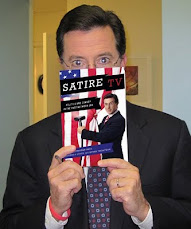What’s left to say about Amy Schumer?
She’s been riding a wave of critical acclaim over the last
year that recently culminated with winning the first Emmy for a sketch comedy program,
preceded by a hit romantic comedy, and a Peabody Award. Her program Inside Amy
Schumer has become the kind of Must See TV that Chappelle’s Show briefly
enjoyed in the mid 2000s. The programs are very similar in their format:
sketches separated by stand-up. Chappelle’s musical guests are replaced with
Schumer’s interviews.
And, of course, whereas Chappelle was must see TV because of
his satiric critiques related to race, Schumer critiques gender norms. As has
been oft-remarked, Schumer is an example of the “unruly woman.” She follows a
line of female comedians that aren’t just funny, but who exceed the bounds of
what is considered socially acceptable for women. Unruly women are talk too
much, are loud, have too much sex, fart, poop, and in other ways exceed bounds
of what is considered normal or acceptable.
In TV, we can trace that line back to Lucille Ball and
Gracie Allen, up to the 80s and 90s with Roseanne Arnold, and Schumer’s
contemporaries Melissa McCarthy and Lena Dunham. Amy, though, works in sketch
comedy versus sitcom or drama, and because of this the boundaries of how the
takes on gender norms are less restricting. Roseanne in a domestic comedy and
so was about motherhood and family. Lena Dunham is also bound by narrative, if
not the domestic. Amy is in sketch and has freer reign, and has proven
relentless in her focus on her own unruliness.
However, I would suggest that because Amy’s show is a sketch
comedy on CC, the “male skewing audience” has meant particular attention to the
question of Amy’s sexual desirability among men. What’s interesting to me is
the success of that critique, and the ways that has perhaps been made more
acceptable to the male audience. I think that the ways in which the critique
has been crouched within media parody is important to this.
That is Inside Amy Schumer emphasizes not being unruly in
culture, but unruly in media culture specifically. Going up against media norms
deflects the critique, and avoids being directly critical of men.
A significant amount of time that Amy has spent talking
about sex has been focused on whether or not the male TV audience wants to have
sex with her. The first scene of the second season dealt with this explicitly
Not only did this scene open the first episode of the second
season, but it also immediately followed what has been IAS’s lead in all three
seasons: Tosh.0. On the air since 2009, that program has been enormously successful,
and IAS’s success has been reported in terms of not how big her audience is,
but how much of Tosh.0’s audience she loses.
This scene directly represents the stereotypical “bad” male
audience member through a collection of dipshit “bros.” Even the guy who says
he appreciates that she provides a feminist perspective on a “male-skewing
channel” is doing so only to set up a joke that he also is only concerned with
talking about whether or not he would fuck her. Finally, the guys battle over
beef jerky and energy drinks. If this is the audience Amy loses, good riddance.
But there’s a implicit argument here also: don’t be like these guys. Be more
sophisticated. You understand how focus groups, etc. work, and you are not like
these guys.
But I think that it is not too difficult to connect this
skit to the male audience that is constructed indirectly through media parody.
That is, there (understandably) aren’t scenes illustrating the smart, ideal,
sophisticated male viewer as that would be incompatible with satiric ridicule.
The prevalence of parody posits a sophisticated male viewer even when it is not
an explicit “behind the scenes” sketch like the focus group. Parody requires
being in on the joke; that is, understanding the media forms being adopted in
order to critique gender norms (Milk Milk Lemonade, Amy Live Blakely).
The ultimate example of this is “12 Angry Men Inside Amy
Schumer.” This is an entire episode devoted to the question of whether or not
Amy is sexually desirable. In contrast to the focus group scene, it is entirely
couched within a remake of 12 Angry Men. This isn’t in order to parody 12 Angry
Men, rather it is parody used as a form for satire. The target here is…not
clear exactly. It’s an incredibly well produced homage to 12 Angry Men, but
only as a format within which to continue the same debate about whether or not
Amy is within the bounds of conventional desirability. It’s another chance to
rehash Amy’s unruliness, but especially to celebrate the cultural savviness of
viewers. The cast are all-stars from film, TV, and comedy. Slowly their true
desires are brought to the surface and they ultimately will agree that Amy
could elicit a “reasonable chub.”
This may be the best example of what I am talking about in
terms of how parody becomes useful as a mode to cage critique of patriarchy and
gender norms within media parody, but the same gesture is present in many other
scenes which are in effect, at least superficially, media parody. Again, the
point is not to parody the media, but to use parody as a form through which to debate
gender norms and critique patriarchy.




















